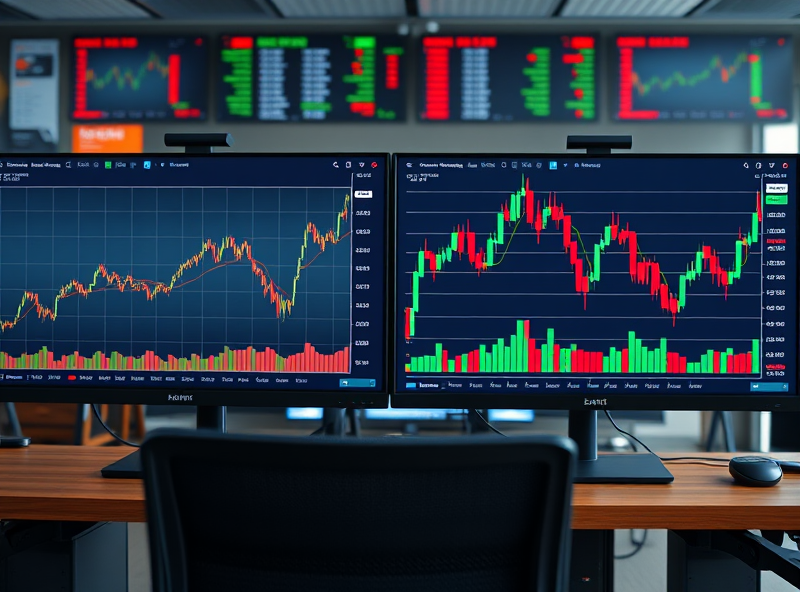
Understanding Financial Market Volatility: Causes & Coping Strategies

Hello, fellow investors! Have you ever watched the stock market charts and seen prices jump or drop significantly in a short period? Or perhaps you’ve felt a knot in your stomach reading headlines about market swings? That feeling is often tied to financial market volatility. Volatility refers to how quickly and dramatically the price of an asset (like a stock, bond, or commodity) changes over time. While it can sometimes bring exciting upward movements, it’s often associated with uncertainty and potential risk, especially when prices are falling rapidly. It’s a fundamental characteristic of financial markets, but understanding *why* it occurs and, more importantly, *how* to navigate it can make a huge difference in your investing journey. You might wonder, “What causes these ups and downs?” or “How can I protect my investments when the market is volatile?” You’re asking questions that are essential for any investor! The purpose of this article is to provide you with a friendly and thorough explanation of the main causes of financial market volatility and, crucially, equip you with smart strategies for coping with it. Let’s explore how you can understand and manage market swings with greater confidence and peace of mind.
What Exactly is Market Volatility?
In simple terms, volatility is a measure of how much an asset’s price fluctuates. High volatility means the price can change dramatically in either direction over a short time. Low volatility means the price is relatively stable. Think of it like the difference between a calm lake (low volatility) and a choppy ocean during a storm (high volatility). Volatility is often measured using statistical concepts like standard deviation, which quantifies the dispersion of returns around an average. However, for most investors, it’s simply the experience of seeing their investment values change significantly from day to day or week to week. It’s important to remember that volatility is a normal feature of healthy, functioning markets. It’s the mechanism through which new information is incorporated into asset prices as investors react to changing circumstances and expectations.
Key Causes of Financial Market Volatility
Market volatility isn’t usually caused by a single factor but rather a complex interplay of various forces. These can range from major global events to subtle shifts in investor sentiment. Understanding these causes can help demystify market movements:
- Economic News and Data: Major economic indicators and news releases can significantly impact market expectations and thus prices. This includes data on inflation (like the Consumer Price Index – CPI), interest rates (decisions by central banks like the Federal Reserve), Gross Domestic Product (GDP) growth, employment figures, retail sales, and manufacturing data. Positive news might lead to optimism and rising prices, while negative news can trigger fear and selling, increasing volatility.
- Political Events and Policy Changes: Political stability, election results, changes in government policy (tax laws, spending bills, regulations), and international relations can all create uncertainty in the market. Geopolitical tensions, trade disputes, or conflicts in key regions can have widespread effects on global markets, leading to increased volatility as investors react to potential risks and shifts in the global landscape.
- Company-Specific Events: News related to individual companies can cause their stock prices, and sometimes the broader market, to become volatile. This includes quarterly earnings reports (whether a company beats or misses expectations), product launches or failures, major lawsuits, changes in leadership, mergers and acquisitions, or even scandals. Positive company news can drive prices up, while negative news can cause them to plummet.
- Market Sentiment and Investor Psychology: Human emotions play a huge role in market volatility. Fear and greed can drive irrational behavior. During periods of optimism, “herd behavior” can lead investors to chase rising prices, creating bubbles. Conversely, during times of fear, panic selling can accelerate market downturns. News headlines, social media trends, and general market mood can significantly influence investor sentiment and amplify price swings.
- Technological Factors: The rise of high-frequency trading (HFT) and algorithmic trading, where powerful computers execute trades in fractions of a second based on complex algorithms, can contribute to rapid price movements and flash crashes. While these technologies can add liquidity, they can also exacerbate volatility during times of stress. The proliferation of financial information and opinions on social media can also quickly spread sentiment, sometimes based on incomplete or inaccurate information, influencing price movements.
- Global Events: Major events that impact the world can trigger significant market volatility. This includes pandemics (like COVID-19), natural disasters (hurricanes, earthquakes), and other unforeseen crises that disrupt economies, supply chains, and daily life on a large scale. These events introduce widespread uncertainty about the future, leading investors to react by buying or selling assets.
- Commodity Price Fluctuations: Significant changes in the prices of key commodities, such as oil, metals, or agricultural products, can impact the costs for businesses and the purchasing power of consumers, leading to broader economic effects that ripple through financial markets and increase volatility.
Understanding that volatility is a response to new information and changing expectations, driven by these diverse factors, is the first step in learning to cope with it.
The Impact of Volatility on Investors
Market volatility affects investors in several ways, some psychological and some financial:
- Emotional Stress: Watching your investment values fluctuate significantly can be stressful and lead to anxiety, fear, or even panic. This emotional toll is one of the biggest challenges of volatility.
- Risk of Emotional Decisions: Fear during downturns can lead investors to sell their investments at a loss, locking in those losses and missing out on potential future rebounds. Greed during upward swings can lead to chasing hot stocks or taking on excessive risk. Emotional decision-making is often detrimental to long-term investment success.
- Uncertainty About Returns: Volatility makes it harder to predict short-term returns. While markets tend to trend upwards over the long term, the path is rarely smooth, and volatile periods can make investors question their strategy.
- Potential for Opportunity (for disciplined investors): For long-term investors who can manage their emotions, volatility can present opportunities. Market downturns caused by panic selling can allow disciplined investors to buy quality assets at lower prices.
Recognizing the emotional impact of volatility is crucial for developing strategies to manage it effectively.
Smart Strategies for Coping with Market Volatility
While you can’t control market volatility, you absolutely *can* control how you react to it. Developing a solid plan and sticking to it is the best defense against the emotional and financial pitfalls of volatile markets. Here are some smart strategies:
- Develop and Stick to a Long-Term Investment Plan: This is the cornerstone of coping with volatility. Define your financial goals (e.g., retirement in 20 years), your time horizon, and your risk tolerance. Create an investment plan based on these factors. When volatility hits, refer back to your plan. Remember that short-term market swings are less relevant if your goal is decades away. A well-thought-out plan helps you stay focused on the big picture and avoid impulsive reactions.
- Diversify Your Portfolio: Don’t put all your eggs in one basket! Diversification means spreading your investments across different asset classes (stocks, bonds, real estate), different industries, different geographic regions, and different company sizes. The goal is to reduce risk. If one investment or sector performs poorly during a volatile period, the positive performance of others in your diversified portfolio can help cushion the impact. Diversification doesn’t eliminate risk or guarantee profits, but it is a fundamental way to manage volatility.
- Practice Dollar-Cost Averaging (DCA): Investing a fixed amount of money at regular intervals (e.g., USD 200 every month) regardless of market conditions is called Dollar-Cost Averaging. When the market is down, your fixed amount buys more shares. When the market is up, it buys fewer shares. Over time, this can result in a lower average cost per share and helps smooth out the effects of volatility. It also removes the emotion of trying to time the market, which is incredibly difficult.
- Maintain an Adequate Emergency Fund: Having a separate savings account with 3-6 months (or more) of living expenses is crucial. This emergency fund means you won’t be forced to sell your investments during a market downturn to cover unexpected expenses like job loss or medical bills. Selling investments when prices are low is one of the most damaging things you can do to your long-term returns.
- Stay Informed, But Avoid Overreacting to News: It’s good to understand what’s happening in the world and the economy, but avoid constantly checking market prices or making investment decisions based on every news headline or social media post. Short-term news often creates noise that can distract from your long-term plan. Focus on reputable sources and broader trends rather than daily market commentary.
- Focus on Quality Investments: During volatile times, quality often shines through. Focus your investments on companies with strong fundamentals, solid balance sheets, consistent earnings (or clear paths to profitability for growth companies), and experienced management teams. These companies are often better positioned to weather economic storms and market downturns than speculative or financially weak companies.
- Understand and Reassess Your Risk Tolerance: Volatility is a test of your risk tolerance. If you find yourself losing sleep over market swings, your current investment allocation might be too aggressive for your comfort level. It might be time to reassess your risk tolerance and potentially adjust your portfolio mix (e.g., increasing your allocation to less volatile assets like bonds).
- Rebalance Your Portfolio Periodically: Over time, market movements can cause your asset allocation to drift away from your target. For example, if stocks have performed well, they might become a larger percentage of your portfolio than you originally intended. Rebalancing involves selling some of the assets that have grown and buying more of the assets that have lagged, bringing your portfolio back to your desired allocation. This helps you manage risk and can involve selling high and buying low.
- Consider Seeking Professional Financial Advice: If you find market volatility particularly stressful or you’re unsure how to create or manage your investment plan, consider working with a qualified financial advisor. They can help you define your goals, assess your risk tolerance, create a diversified portfolio, and provide guidance and emotional support during volatile periods.
Implementing these strategies can help you approach market volatility with a sense of control and confidence, rather than fear.
Volatility as a Normal Part of the Investment Cycle
It’s helpful to view volatility not as an anomaly, but as a normal and expected part of investing. Historically, financial markets have always experienced periods of calm followed by periods of turbulence. These fluctuations are part of the process through which markets discover fair prices and respond to the ever-changing global environment. While volatility can be uncomfortable in the short term, it is often during volatile periods that long-term opportunities are created for disciplined investors who stick to their plan and continue investing. Trying to avoid all volatility is impossible if you want to pursue long-term growth potential. The goal is not to eliminate volatility, but to understand it and manage your response to it effectively.
Looking Ahead: Navigating Future Swings
Predicting exactly when and why market volatility will occur is impossible. The global economy is influenced by countless factors, and unexpected events will always arise. However, by understanding the common causes we’ve discussed – economic data, political events, company news, sentiment, and global crises – you can have a better sense of the forces at play when volatility increases. The future will undoubtedly bring more periods of market swings. The key to navigating them successfully lies in preparation, discipline, and a long-term perspective. Focus on building a robust investment plan, diversifying wisely, investing consistently, and controlling your emotional reactions. These timeless strategies are your best tools for building wealth over the long haul, regardless of the short-term ups and downs of the market.
Your Action Plan: Stay Calm and Invest On!
We’ve explored the various causes behind financial market volatility, from economic indicators and political events to market psychology and global crises. We’ve also discussed why understanding volatility and its impact is crucial for investors. Most importantly, we’ve outlined practical strategies for coping: having a long-term plan, diversifying, using Dollar-Cost Averaging, maintaining an emergency fund, staying informed but avoiding overreaction, focusing on quality, understanding your risk tolerance, and rebalancing. Remember, volatility is a normal part of the investment landscape. Your ability to remain calm, disciplined, and focused on your long-term goals during turbulent times is often the most important factor in determining your ultimate investment success. Don’t let short-term swings derail your future. Take action today by reviewing your investment plan, ensuring your portfolio is diversified, and committing to consistent investing. By doing so, you empower yourself to navigate market volatility with confidence and work towards achieving your financial aspirations. Wishing you patience, discipline, and success in your investing journey! 😊







